Rick's Canadian Penny Collection
Welcome to my collection!
I've been collecting Canadian pennies ever since I was a little boy. I used to have one of those cardboard folder booklets with the little cut out circles where you pressed your pennies into. The booklet had a blue cover, as I recall. I believe my parents bought me them for Christmas one year. None the less, it started my fascination with pennies that continues to this day. At present, I've collected over 100 pennies, covering a vast array of years. The collection is by no means complete, nor is it of much value. I'm not one of "those" collectors, that has to have high quality, non-circulated coins. I prefer beat up and dirty coins. I find they have much more character, and I'd rather ponder who else might have held these coins in their hands? Sir John A. MacDonald? Billy Bishop? Pierre Elliot Trudeau? Charlie Farkison? Who knows!
The side benefit of collecting Canadian pennies that aren't exactly pristine, is that it keeps the cost of my hobby way down! Hopefully you'll find this collection interesting and enjoyable.
Victoria, Province of Canada (1858-1859) - Large Cents
After several attempts at introducing acts to have Canada produce it's own currency, in 1857 the government of Britain finally approved the production of Canadian coinage. It was decided that the new Canadian money would be based on a decimal system instead of the pounds/shillings that Britain used. Thus, a new one cent coin (as well as 5, 10, 25, etc) was required. The design chosen featured a motif of 16 serpentine maple leaves on the reverse side and a youthful, idealized bust of the queen wearing a laurel wreath on the obverse side. In fact, by the late 1850's, the queen was quite pudgy and decidedly older looking than the coinage portrait suggested.
The government optimistically ordered approximately 10,000,000 1-cent pieces, which proved to be much more than the province could absorb. The coins would last almost 10 years after confederation (1867) before new coins needed to be minted.
Victoria, Dominion of Canada (1876-1901) - Large Cents
At the time of Confederation in 1867, the new Government Of Canada inherited the outstanding cents produced in 1858-1859. It was decided to issue them as Dominion cents and it took nearly ten years to use up the stock. Thus, the first cents struck for the Dominion came out in 1876. The reverse was the same as the 1858-1859 pennies, but the obverse used a diademed head adapted from that used for the Jamaica halfpenny. The government also increased the weight to 1/80th of an avoirdupois pound, the same as the British halfpenny.
King Edward VII (1902-1910) - Large Cents
In 1901, Queen Victoria passed away of old age, and her eldest son, Edward, took the throne. He was the son of Prince Albert of Germany, and thus the royal house changed during his reign (from the House of Hanover to the House of Saxe-Coburg-Gotha). The reverse of the penny continued the Victorian design, and the obverse now sported a portrait of the new King. Edward died on May 6, 1910 after a series of heart attacks.
King George V (1911-1920) - Large Cents
George was the second son of King Edward VII and became heir apparent when his older brother Albert passed away in 1892. Until then, George was a naval officer and a career man. After 1892, he wed Mary of Teck and had four sons and one daughter. The penny had minor changes to the reverse (the word "CANADA" was added, and it was removed from the obverse.) and the obverse had a portrait of the new King. Also of interest was the lack of the Latin phrase "DEI GRATIA" (or an abbreviation for it), which caused the 1911 coin to be termed "Godless". In 1912, "DEI GRA:" was added to the coinage tools.
King George V (1920-1936) - Small Cents
As a matter of economy, the Canadian government introduced in 1920 a small cent similar in size and composition to that of the United States. The large cents were allowed to circulate until the late 1930's, at which point they were retired. The obverse design was the same (albeit smaller), while the reverse featured a completely new design featuring two maple leaves. King George V died in 1936 of bronchitis.
King George VI (1937-1952) - Small Cents
In 1936, King Edward VIII took the throne, as he was the eldest son of King George V. However, he decided to marry an American divorcee (Wallis Simpson) and thus abdicated the throne to his younger brother George. The 1937 cent introduced the Latin abbreviation "ET IND:IMP:" to the obverse, indicating that King George VI was also the Emperor of India. This was included until 1947. King George VI died of cancer in 1952.
Queen Elizabeth II (1953-1981) - Small Cents
Elizabeth, eldest child of King George VI, took the throne in 1953, and she still reigns today. During her time, she has seen many changes throughout the world - the fall of Communism, the breaking of the Berlin Wall, the end of the Cold War, etc. Importantly for us, she signed off our Constitution in 1982 when Prime Minister Trudeau helped Canada become a fully independent nation - still a member of the Commonwealth, though. The penny has gone through a number of changes over the past 50+ years. The first portrait of Queen Elizabeth II was of a young lady with a laurel wreath in her hair. The reverse featured a continuation of the maple twig introduced in 1937. The portrait of the Queen changed in 1965 with an updated model featuring a tiara in her hair. 1967 saw a one year replacement of the maple twig with a rock dove - commemorating the centennial of Confederation. In 1979, the tiara portrait was made smaller to make the size of the portrait proportional to the diameter of the coin (the same portrait was used on all Canadian denominations).
Funny story - in 1979, the mint tried to reduce the diameter of the cent to 16mm from 19.05mm. Unfortunately, it was the same size as the tokens used by the Toronto Transit Commission (the TTC), so the plan was scrapped. In 1980, they introduced a slightly smaller coin that was a bit lighter - 19mm instead of 19.05mm.
Queen Elizabeth II (1982-2012) - Small Cents
In 1982, the coins went from a round edge to a 12 sided edge. The composition of the coins has changed a lot over the years, with steel replacing copper as the primary metal.
The portrait of the Queen would change several times over this time period. In 2003, there were two different portraits of the Queen - one a continuation of the previous series, and a new, modern portrait where she has no tiara in her hair.
In 2012, the Canadian government discontinued the penny as part of its currency.
History of Canadian Pennies
In the early 19th century, coinage in Britsh North America consisted of scarce English coinage combined with coinage from other countries such as Spain, Mexico and the U.S., as well as privately issued coins. It was clearly time for the colonies to have their own coinage issued. To that end, Sir Francis Hicks helped to introduce a series of acts, starting in 1850 that evenutally led to the issuance of Canada's own currency - including a decimal-based penny! The 1858 and 1859 pennies featured a very youthful looking Queen Victoria with a laurel wreath in her hair. The design of these coins was done by Leonard C. Wyon.
Half a million coins were minted in 1858 with ten million more minted in 1859. This vast quantity of coins kept circulation so high that a new minting wasn't required until 1876 - almost 20 years later! These early coins were 1 inch in diameter, and are referred to as large pennies. In 1859, some dies were reused from 1858 and the date was overpunched to read 1859. This resulted in four different looking date stamps for 1859 - and because of the differing numbers, today those coins carry different values:
- 9 punched over 8, wide 9 - this shows a very bold looking 9, and if you look closely, you can see the narrower part of the 8 stamped underneath it. These coins are quite valuable:
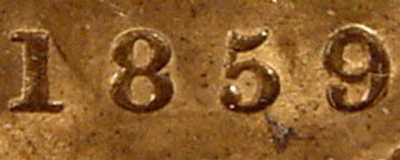
1859 Penny - 9 punched over 8
- Narrow 9 - many of the coins were punched normally (not an overstrike on an 8) and these coins are worth the least - althought still decently valuable.
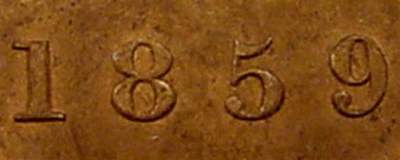
1859 Penny - Narrow 9
- Double Punch #1 - Some of the coins were double punched 9 over 9 - no 8's involved! This led to two different appearances, but both look messier than the 9 punched over 8, wide 9 as listed above. Variant #1 has the tail of the 9 attached to the upper loop - sometimes mistaken for 9 punched over 8, wide 9. This type is the most valuable of the 1859 pennies!
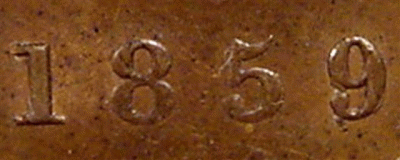
1859 Penny - Double Punched 9, Version #1
- Double Punch #2 - This is the same as #1 above, except there is a gap between the bottom of the tail of the 9 and the upper loop.
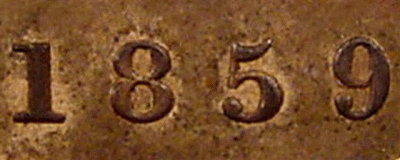
1859 Penny - Double Punched 9, Version #2
You can use the guide above to try and figure out what kind of 1859 penny you might have. As mentioned, the coins resumed being minted in 1876, and then again took a break until 1881. At that point, more or less regularly, the coins were minted every year (with a few exceptions in the 1880's). In 1891 there was once again major differences among the coins minted:
- The reverse of the coin was modified to show small leaves instead of the previous larger leaves.

1891 - Large Leaves

1891 - Small Leaves
- Additionally, some coins had a bolder "large" date of 1891, where as some coins had a lighter "small" date. (no photos available yet)
In 1911, the penny and other coins (nickle, dime, quarter and 50 cent piece) were missing DEI GRATIA ("by the grace of God") and the public took notice and complained. These were referred to as "Godless" coins, and in 1912 the words DEI GRA appeared (an acceptable abbreviation).
In 1920, the coins changed from a large diameter of 1 inch to a small diameter of 3/4 inch (19.05mm) in order to save copper and to have the Canadian penny be the same size as the American penny.
Over the years, many versions of the Canadian penny have a small "H" located somewhere on the reverse side of the coin (the side opposite to the image of the King or Queen) - these are Heaton issues which were produced at the Birmingham Mint instead of the Royal Mint in London (the coins of which had no such marking).
In 1947 some pennies have a small maple leaf after the date, signifying these coins were actually struck in 1948. This happened when there was a pressing demand in early 1948 for coins of all denominations, yet the mint was still waiting on the revised dies for 1948. Thus, it was decided to modify the 1947 die with the small maple leaf, to allow coins to be produced.
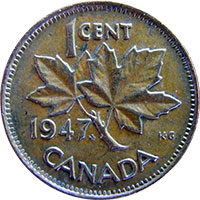
1947 Maple Leaf Penny
Starting in 1953 and then for the two years following, there were two different versions of Queen Elizabeth on the coins. The initial issue had a high relief portrait on the queen that did not strike well. The relief was lowered and the design enhanced to improve the strike. The result was that the should strap of the Queen's dress was almost invisible in the first issue, and quite noticable in the second issue. The differences in value of those coins depend on whether the should strap is present or not. (no photos available yet)
In 1965 there were a couple of variables on the coins. The beads that go around the outside of the coin had a large bead version and a small bead version. Additionally, the "5" in 1965 could either have a slightly pointed top to the 5, or a blunt top. Variations mixing both variables exist, so 4 different combinations are present. (no photos available yet)
Again in 1985 there was a blunt 5 and a pointed 5. What is with these guys and years ending in 5??











































































































































































































































































